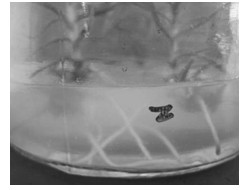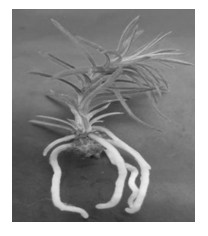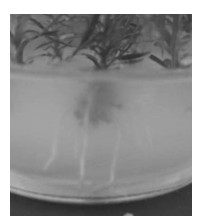Isolated rooting culture method for fir clone
A technology for rooting culture and rooting medium, which is applied in the field of vegetative propagation of Chinese fir, can solve problems such as difficult rooting of tissue culture seedlings, and achieves the effects of solving the problem of difficult rooting, improving social benefits, and accelerating industrialization development.
- Summary
- Abstract
- Description
- Claims
- Application Information
AI Technical Summary
Problems solved by technology
Method used
Image
Examples
Embodiment 1
[0029] Example 1 Differentiation and elongation of buds
[0030] Each tissue culture material (Yang 062, Yang 020, Yang 061, Yang 023 and Yang 021) was cultured in the subculture medium to induce differentiation of adventitious buds. The formula of the subculture medium was 3 / 4MS+6BA0.3 mg ·L -1 +NAA0.02mg·L -1 + 3% sucrose. The induced differentiated adventitious buds were transferred to MS medium without any growth regulators for elongation culture.
Embodiment 2
[0031] Embodiment 2 induces rooting
[0032] When each adventitious bud of embodiment 1 grew to 2~3cm, it was transferred to rooting medium to cultivate its rooting. Add plant growth regulators and 2% sucrose to the rooting medium and observe the statistics. Data statistical indicators include: induction frequency of adventitious roots (%) = number of adventitious buds that grow adventitious roots / number of inoculated adventitious buds × 100%; average adventitious root number = total number of adventitious roots / number of adventitious buds that induce adventitious roots; formation ability of adventitious roots ( RFC) = average number of adventitious roots × induction frequency of adventitious roots.
[0033] In Yang 062 culture, the selection of rooting medium and plant growth regulator and the corresponding experimental results are shown in Table 1. It can be seen from the table that the medium with added NAA is the best for rooting. When the concentration of NAA-1 When the ...
Embodiment 3
[0053] Inoculate Yang061 in 1 / 4MS+NAA0.1mg·L -1 +IBA0.2mg·L -1 In the culture medium, different concentrations of activated carbon (Table 7) were added to the culture medium, and the culture method was the same as in Example 2, and the statistical results were observed after 35 days. After being inserted into the activated carbon medium, the growth of the aseptic seedlings was weak, and adventitious roots were found to grow on the 26th day. It can be seen from Table 7 that the rooting rate on the medium added with 0.02% activated carbon was 46.7, and the rooting rate continued to decrease with the increase of activated carbon concentration. %. It can be seen that activated carbon is not conducive to the rooting of fir adventitious buds.
[0054] Table 7 The effect of active carbon on the rooting of Yang 061
[0055] Activated carbon (mg / L)
PUM
| Property | Measurement | Unit |
|---|---|---|
| Length | aaaaa | aaaaa |
Abstract
Description
Claims
Application Information
 Login to View More
Login to View More - R&D
- Intellectual Property
- Life Sciences
- Materials
- Tech Scout
- Unparalleled Data Quality
- Higher Quality Content
- 60% Fewer Hallucinations
Browse by: Latest US Patents, China's latest patents, Technical Efficacy Thesaurus, Application Domain, Technology Topic, Popular Technical Reports.
© 2025 PatSnap. All rights reserved.Legal|Privacy policy|Modern Slavery Act Transparency Statement|Sitemap|About US| Contact US: help@patsnap.com



